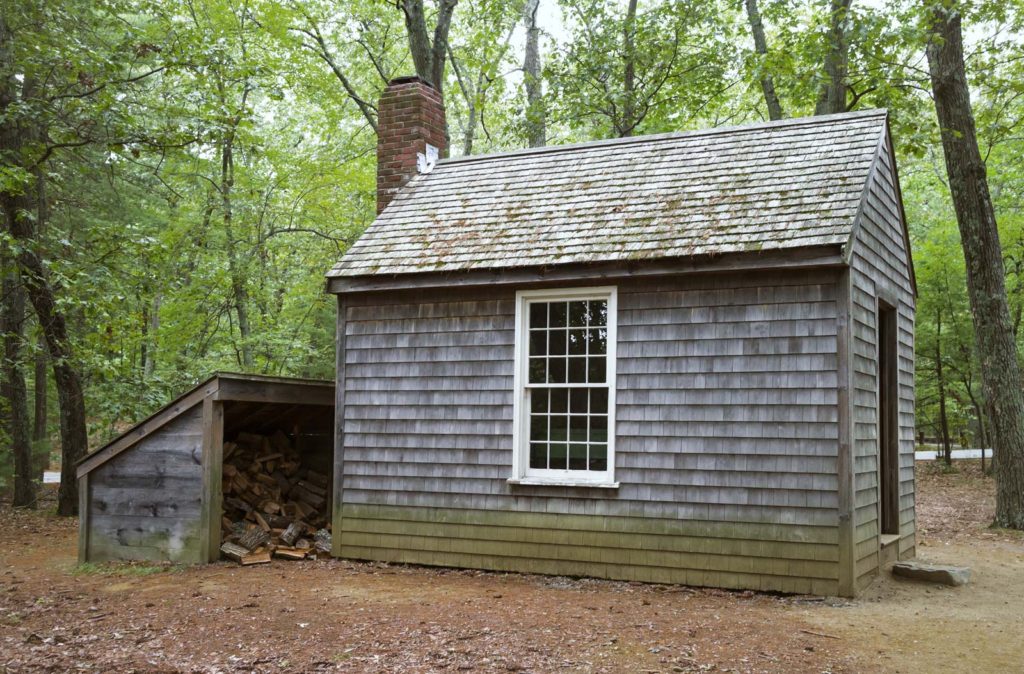Philosophy, environmentalism, political activism, and life in the woods. Part of our heritage. Celebrate Thoreau’s birthday on July 12 (1817) by living simply and taking a hike.
Table of Contents
ABOUT HENRY
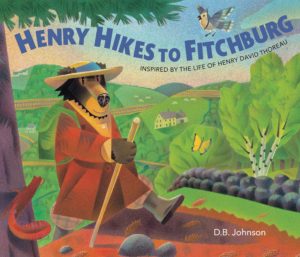 |
In D.B. Johnson’s Henry Hikes to Fitchburg (Houghton Mifflin Harcourt, 2006), inspired by Walden, Henry and a friend – both bears – prepare to go to Fitchburg, 30 miles away. The friend decides to work and save enough money to take the train; Henry, however, decides to walk, enjoying nature along the way. Sequels include Henry Builds a Cabin, Henry Climbs a Mountain, Henry Works, and Henry’s Night. For ages 4-8. |
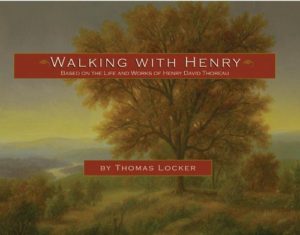
|
Thomas Locker’s Walking with Henry (Fulcrum Publishing, 2011), illustrated with Locker’s beautiful paintings, follows Thoreau as he hikes through the wilderness. (“When he awoke, the grass was covered/with morning dew. It looked like a mirror/broken into a thousand fragments/wildly reflecting the full blaze of the rising sun.”) Included is a timeline of Thoreau’s life. For ages 4-9. |
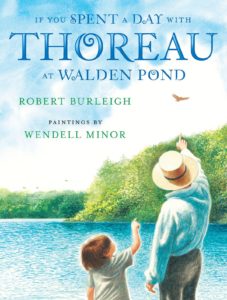 |
In Robert Burleigh’s If You Spent a Day with Thoreau at Walden Pond (Henry Holt and Company, 2012) – illustrated with gorgeous paintings by Wendell Minor – a small boy in blue jeans knocks on the door of a little house in the woods and then proceeds to spend a gentle, magical day with the owner: Henry David Thoreau. (“If you spent a day with Henry David Thoreau, you would need to get there early because Henry wakes with the sun.”) Appendices include background information on Thoreau and a list of Thoreau quotes. A lovely read for ages 5-10. |
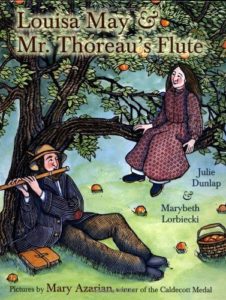 |
In Julie Dunlap and Marybeth Lorbiecki’s Louisa May and Mr. Thoreau’s Flute (Dial, 2002), seven-year-old Louisa May Alcott is fascinated by independent-minded Henry David Thoreau, who carries a flute in his pocket, tucks a pencil behind his ear for jotting down notes in his journal, and takes the children on nature walks. Louisa – nicknamed Louy – has some independent thoughts of her own, and Mr. Thoreau’s example eventually helps her find her own way to writing. For ages 5-9. |
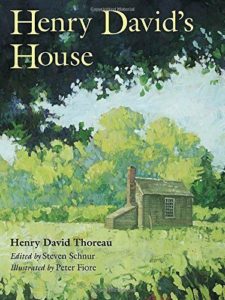 |
Stephen Schnur’s Henry David’s House (Charlesbridge, 2007) is a picture-book adaptation of Walden with quotations from the original for ages 5-9. |
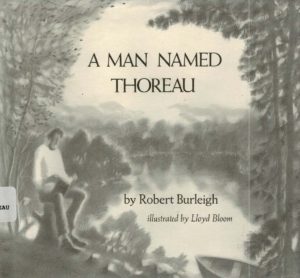
|
Robert Burleigh’s A Man Named Thoreau (Atheneum, 1985) is out of print, but well worth tracking down – a simple story of how, though his life may have looked odd and pointless to some, Thoreau was thinking, observing, and having ideas that have become important to us all. Illustrated with lovely charcoal drawings. For ages 6-10. |
 |
Michael McCurdy’s Walden Then and Now: An Alphabetical Tour of Henry Thoreau’s Pond (Charlesbridge, 2010) is an overview of Walden, past and present, illustrated with great woodblock prints. It’s designed like a child’s alphabet book: a short alphabetical phrase describes something Thoreau himself experienced or saw – A is for the angry ants whose battles Henry described in Walden; B for the bean field he planted – while a following paragraph provides information about the changes that have taken place in modern times. “J is for the joy he felt at being alone,” for example, is paired with a text explaining that Walden Pond now is visited by 600,000 people a year. For ages 8 and up. |
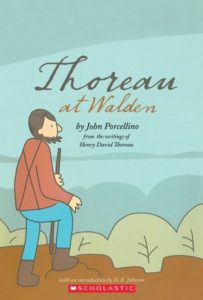 |
John Porcellino’s Thoreau at Walden (Disney-Hyperion, 2018) is a graphic novel version of Thoreau’s life and work, studded with famous quotations. For ages 10 and up. |
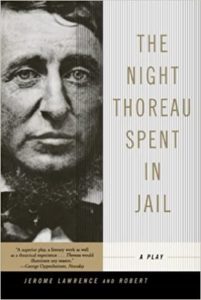 |
By Jerome Lawrence and Robert E. Lee, the play The Night Thoreau Spent in Jail (Hill and Wang, 2001) is a brilliant account of Thoreau’s life and philosophy, centered around the night he spent in jail for refusing to pay taxes to support the Mexican-American War – a war fought without Congressional approval and a blatant example of imperialism. A wonderful, witty, and discussion-provoking read for teenagers and adults. |
| The Night Thoreau Spent in Jail is a teacher’s guide to accompany the play with background information and discussion questions. | |
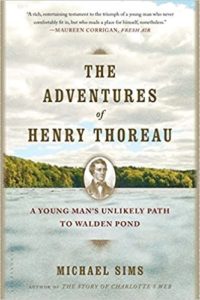 |
Michael Sims’s The Adventures of Henry Thoreau (Bloomsbury USA, 2014) traces Thoreau’s life from his boyhood (he liked to ice skate, sing, and walk in the woods) through his education at Harvard, his friendship with Ralph Waldo Emerson, his famous cabin at Walden Pond, and his transformation into world-famous author and environmentalist. For teenagers and adults. |
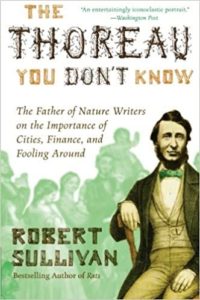 |
Robert Sullivan’s biography The Thoreau You Don’t Know (Harper Perennial, 2011) points out that Thoreau – rather than just an oddball loner who disliked new suits of clothes – was friendly, chatty, and lived most of his life in town. An interesting and informative read for teenagers and adults. |
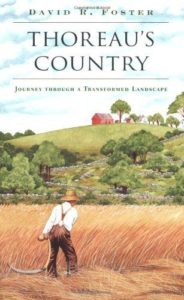 |
Ecologist David R. Foster’s Thoreau’s Country (Harvard University Press, 2002) describes how – equipped with Thoreau’s journals – the author built his own cabin in the woods, and then set out to explore how the New England landscape has changed since Thoreau took to the woods in the 19th century. For teenagers and adults. |
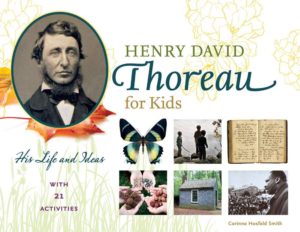 |
Corinne Hosfeld Smith’s Henry David Thoreau for Kids (Chicago Review Press, 2016) has an overview of Thoreau’s life, times, and ideas, with illustrations, fact boxes (“What is Transcendentalism?”), and related activities, including making a journal, conducting a plant inventory, and writing a protest letter to an official or editor. For ages 9 and up. |
| The Thoreau Society provides education about Thoreau’s life, works, philosophy, and place in the world, and hosts many events for all ages. The website has a Thoreau biography and family tree, maps of Thoreau’s travels, synopses of Thoreau’s works, and more. | |
 |
By Ken Burns, Walden (2017) is a short documentary on the life and works of Henry David Thoreau. |
| See Transcendentalism: An American Philosophy for a brief overview, with mentions of some of its more prominent followers. | |
| Henry David Thoreau is a collection of interesting and varied articles on Thoreau from the New York Times. For example, in A Man For All Seasons, find out how Thoreau’s writings are helping modern scientists analyze climate change. | |
| From Philosophy Slam, Henry David Thoreau has an overview of Thoreau’s philosophy with a list of discussion questions and associated links. | |
| For more resources, see Philosophy. |
INTO THE WOODS
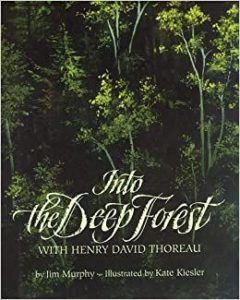 |
Jim Murphy’s Into the Deep Forest with Henry Thoreau (Clarion Books, 1995), peppered with excerpts from Thoreau’s own journals, traces Thoreau’s trips through Maine, on foot and by canoe. For ages 7-11. |
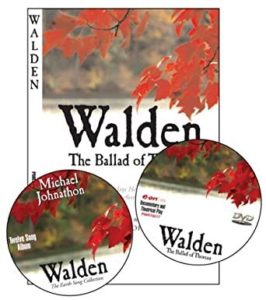 |
Michael Johnathon’s play Walden: The Ballad of Thoreau is a four-character play featuring a conversation between Thoreau and Emerson as Thoreau prepares to leave his cabin on Walden Pond. Download the script and accompanying lesson plans at the website above. |
| Michael Johnathon’s Walden: The Ballad of Thoreau is a collection of 11 acoustic songs based on Thoreau’s stay at Walden Pond. Included are extensive educational notes. Song titles include “In the Woods,” “The Cabin,” and “Simple Life.” | |
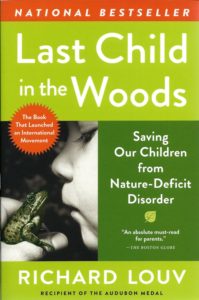
|
Back to Thoreau! Richard Louv’s Last Child in the Woods (Algonquin Books, 2008) discusses the demise of unstructured outdoor play – that is, going outside and running around in the woods – and points out how our alienation from nature (he calls it “nature-deficit disorder”) is damaging. |
| The Walden Woods Project is a non-profit organization dedicated to preserving the land, literature, and legacy of Henry David Thoreau. The website has information on the Walden Woods ecosystem, activity and curriculum guides, background information on Thoreau’s life and work, and photo galleries. | |
 |
In May 1862, shortly after his death, the Atlantic magazine published Thoreau’s famous essay, Walking. Pair it with a hike. |
Pages: 1 2
